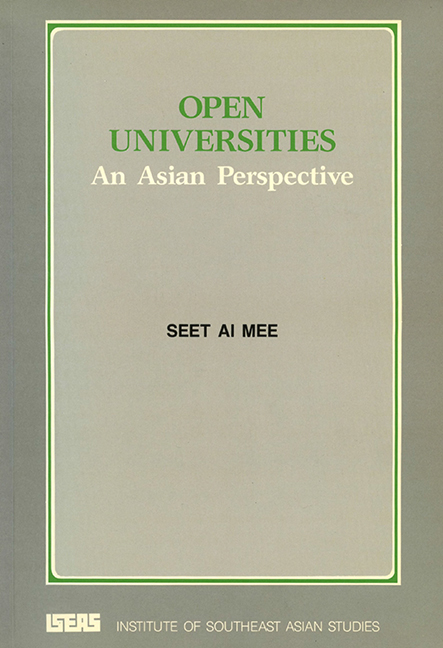Book contents
- Frontmatter
- Contents
- Acknowledgements
- I Introduction
- II Open Universities
- III The Quality of Distance Education
- IV Science and Technology Teaching
- V Continuing Professional Education
- VI Costs of Distance Education
- VII Concluding Remarks
- Notes
- Select Bibliography
- Abbreviations
- Member Institutions of the Association of Asian Open Universities
- THE AUTHOR
III - The Quality of Distance Education
Published online by Cambridge University Press: 21 October 2015
- Frontmatter
- Contents
- Acknowledgements
- I Introduction
- II Open Universities
- III The Quality of Distance Education
- IV Science and Technology Teaching
- V Continuing Professional Education
- VI Costs of Distance Education
- VII Concluding Remarks
- Notes
- Select Bibliography
- Abbreviations
- Member Institutions of the Association of Asian Open Universities
- THE AUTHOR
Summary
From Thailand to Israel, discussions on distance education focus on quality. With the maturing of distance education has come rapid recognition of the need of quality to satisfy the educational demands of persons and needs of nations. The concern for quality in education, particularly in higher education, is expressed in most policy and planning documents and recurs even in the best of institutions.
The question often asked is: For distance education, is relevance going to be the criterion for quality? For most open university programmes in Asia and developing countries, courses offered are, by and large, need-based. Nearly 85 per cent of the 150,000 students of Sukothai Thammathirat Open University (STOU) in Thailand are working adults, and the Allama Iqbal Open University in Islamabad (AIOU) lays strong emphasis on the training of primary school teachers, literacy workers and village leaders side by side with its degree programmes.
There is a tendency to compare distance learning universities and conventional universities. Doubts are often expressed over the quality of print and media materials of the courses and concern is expressed for the levels of achievement attained in distance education. Such reactions are understandable, but there is no evidence to show that one approach is necessarily superior to the other. Indeed, it is reported that STOU graduates are doing equally well and in a few instances better than graduates of conventional universities in postgraduate entrance examinations.
Quality is relative. Nevertheless, maintaining quality must be a long-term perspective. Short-term gains in “mass education” where the numbers game is evidence of success must not overshadow the need for quality.
In the consideration for quality, there is need to ensure that it is practised at several levels:
(a) development of materials, i.e., the content of delivery;
(b) modes of delivery;
(c) student support systems;
(d) training of personnel;
(e) monitoring and evaluation.
- Type
- Chapter
- Information
- Open UniversitiesAn Asian Perspective, pp. 11 - 20Publisher: ISEAS–Yusof Ishak InstitutePrint publication year: 1992

